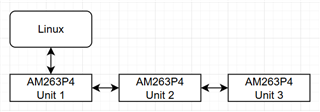Tool/software:
We are considering using the 2 ethernet ports on the AM263P4 MCUs to daisy chain multiple units together.
The plan is to use Ethernet and the CPSW block. Currently the Ethernet works using the LWIP and enet stack. (enet_lwip_cpsw example)

We may potentially daisy chain up to 7 units together.
With your expertise, can you please provide comments regarding implications and challenges to this before we commit to this topology?
Some questions:
- Does CPSW and LWIP support daisy chaining?
- On unit 1, will the CPSW hardware automatically forward all the downstream packets or will all 7 unit's traffic be processed by enet driver taking up RAM and CPU time?
- Are there any examples of CPSW daisy chaining?
- Any other comments or concerns?
Thank you for the support.

